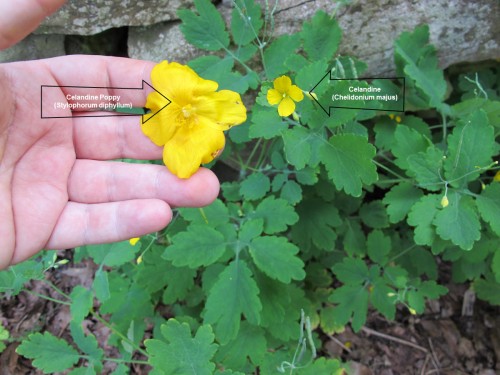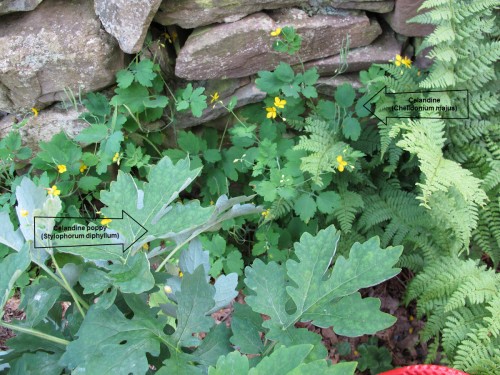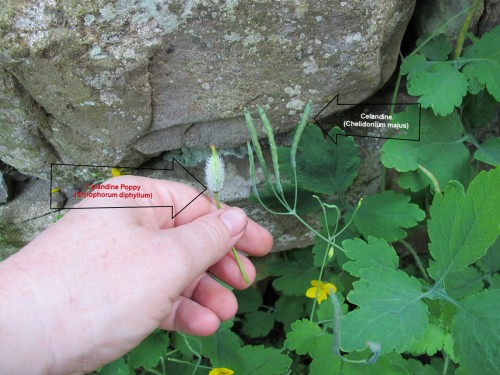There are three plants with yellow flowers called celandine in the British Isles: the Greater Celandine (Chelidonium majus), the Lesser Celandine (Ranunculus ficaria), and the Celandine Poppy (Stylophorum diphyllum). Over here on the other side of the pond, the lesser celandine is not nearly as common as other buttercups and isn’t mentioned much in North American wildflower literature (at least in my reading), so the Greater Celandine is just called Celandine. (Click on each photo to enlarge it and make the text easier to read.)

The flower of the North American native Celandine poppy is quite a bit larger than its European cousin
That’s confusing enough, but they look pretty similar, too, at least, when you don’t see them together. Celandine (Chelidonium majus), is native to Europe, not North America, and is generally regarded as a weed here. But when I look at it, I always mistake it for the Celandine Poppy (Stylophorum diphyllum), a desirable North American native. Usually I figure out my mistake when I see another gardener cavalierly yanking out the Celandine while giving me a tour of their garden.

The leaf shape of the European Celandine is vaguely reminiscent of the North American Celandine Poppy's leaf shape, but they are easy to distinguish when side by side.
So, I had the Celandine growing in the Wall Garden bed facing the carriage barn. I looked at it and thought, “Oh, good, I’ve already got that native plant growing here where I want to plant all the other native woodland plants.” But I had the Celandine Poppy, the true native, growing in the shade garden at my old house, and I finally figured out I was coddling the impostor at the new house. When I dug up the native Celandine Poppy from the old house and brought it over to the new garden, I had a unique opportunity to photograph the two side by side.
As you can see, it’s not at all difficult to tell them apart when they are together, but when I haven’t seen the Celandine Poppy for a while, the Celandine looks enough like it to confuse me. After doing this little exercise, I doubt I will get them confused again. How about you?
Posted for Wildflower Wednesday, created by Gail of Clay and Limestone, to share wildflowers/native plants no matter where you garden in the blogasphere. “It doesn’t matter if we sometimes show the same plants. How they grow and thrive in your garden is what matters most. It’s always the fourth Wednesday of the month!”






Looking to identify a plant that is very similar to this one w/ the yellow flowers and pod but the only difference are the leaves. The ones on one I have are more rounded. Any help?
Thank you so much for the celandine comparisons! Would like to have found the Wood Poppy in my native plant area of the garden but am happy meantime with the Greater Celandine here in Ottawa, Ontario.
Thank you so much…. I have a native wf book, and the images made me think I had the EU version, so I dug it up and potted it, thinking it would be hyper invasive. Now, I guess I will replant it in the soil.
I went completely bats last Spring trying to tell them apart as both have seeded themselves in a patch of woods. Only when they finally bloomed did I realize that, fortunately, the poppy had seeded itself well and I have numerous new plants. Unfortunately something ate one large plant down to a nub, but next Spring may be better. The lesser celandine grows on some bluffs along Lake Ontario near here and,fortunately, I did not follow my impulse to move some of it to my garden as it is a self seeding terror and difficult to get rid of as it grows from tuberous roots that are difficult to dig out once you get them. K.
The only place I ever saw celandine poppy was growing as a ‘weed’ in front of a local library where it was quite shady. I pulled out some of it from time to time, but I thought it was so pretty.
I didn’t realise there where different types either…so I’ve learnt something today! Smashin that.
a celandine was always a celandine to me. i never realized (or thought to check) that there were three different varieties. i’m going to have to start taking closer looks at them.
Does anybody knows what are the home uses for Celandine? Can it be used to make essential oil?
This meme is a great idea, just come in from gails site.
an interesting post Kathy, I have never seen greater celendine and didn’t realise how different it is to lesser celendine, I like your celendine poppy, it can be difficult knowing what is growing when still small last year I was digging out what I thought was buttercup as I have a lot of it only to find I was digging up the musk mallow I had scattered seeds of, musk mallow has 2 different leaves at different stages, Frances
Hi Kathy, Thanks for sharing this information. I have a couple of the non native kinds that a friend of mine gave me, as she has lots of them. They don’t seem to be doing all that well. Maybe I should pull them so they don’t decide to grow and multiply.
I’ve never seen the celadine growing as a weed here. It’s a pretty little thing, but thanks to your warning and photos, I will not be welcoming it into my garden.
I can’t figure out why Stylophorum diphyllum won’t grow in Gail’s garden. It thrives in my very well-drained soil under boxelders in my garden.
Hooray! For once what is growing here is the native and not some meddlesome invader from faraway lands. Thanks for the good info!
Thanks for such an informative post, Kathy! I have trouble distinguishing many plants when they’re seedlings; I’ve nurtured a lot of “imposters” before realizing my mistake:)
Oh, Rose, I have done that, too! Many weeds have interesting rosettes of leaves the first year, and the second year disperse seeds by the millions. Motherwort is one like that, and devil’s beggar-tick also tricked me.
Thanks Kathy for sharing the two celandines! I love the native plant and hope it likes the new garden! To my great disappointment, I’ve been unable to make it happy at C and L. Not sure why, but, it could be it’s just too dry! I keep trying! gail